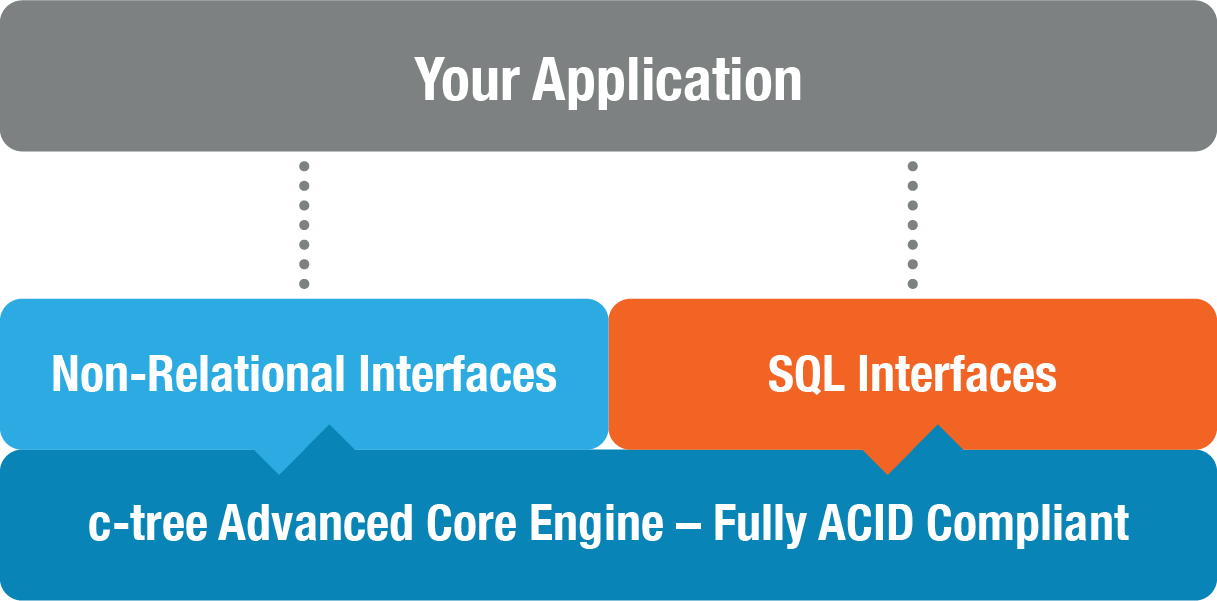FairCom’s c-treeACE database technology enjoys a rich 35-year history as we continue to watch the database industry thrive and change. In fact, at no time in technology history has the database landscape shifted more, and faster, than the last several years. Quickly-changing technologies—and terminologies—bring many new options and questions to data developers and consumers.
A History of Strength
FairCom has always been and remains a champion of solid Online Transaction Processing (OLTP) solutions and flexible data access. We continue to strive to bring you fast, dependable database technology while challenging ourselves to deliver the richest data access toolset on the market. This includes our extensive assortment of ISAM and SQL APIs as well as our unique ability to broaden this scope with implementations of SQL access over non-traditional, unstructured data.
Alternative data models, including record-oriented (ISAM) technology, are categorized today by many as “NoSQL.” Newer database technologies have embraced this proven data storage method with many new approaches that mostly ignore a data schema. However, because these newer technologies lack the power of structured query language, they are unable to leverage data to the fullest advantage.
Successful integrated solutions have garnered the term “multimodel database.” We believe we are a strong contender in this new multimodel arena—industry analysts such as Gartner are agreeing, as evidenced by the inclusion of FairCom in the 2015 Gartner Magic Quadrant for Operational Database Management Systems.

What is NoSQL?
The convergence of cheap storage and massively interconnected social, mobile, and Internet of Things (IoT) data has created a wealth of information to store and search. Not only sheer database size, but the rate of collection has contributed to newer and faster data storage technologies. Merging data from these disparate data sources requires different approaches than traditional relational database products are able to provide.
NoSQL encompasses a wide range of technologies in attempts to solve these data challenges. NoSQL started as “Not Only SQL” implying alternative approaches from structured relational SQL. Each of these technologies targets a specific category of data management:
In addition, an assumption of massive scalability and availability is implicit. To accomplish this, compromises must sometimes be made.
Unstructured Data
A key element of today’s data storage involves rapidly changing data. Historically, database administrators spent considerable time designing and normalizing data structures for optimal storage size and query performance—“data follows the schema.” Today, ever-changing business requirements dictate a need for much more flexible data acquisition. Traditional database schemas constrain the multiple flows of data that can be acquired. Consider merging web server logs with other analytic data. Much of this data fails to follow consistent data schemas. An “unstructured” storage approach is desired. If needed, a structured data query can be defined later—“schema follows the data.”
Transactional Technology
Traditional database technology has matured with OLTP applications. Indeed, database benchmarks (TPC-C, TPC-E) are typically a direct measure of OLTP performance. OTLP, strongly rooted in financial and inventory management systems, has classically implied the need for solid transaction integrity, better qualified as ACID—Atomicity, Consistency, Isolation, and Durability. But transaction durability comes with a performance cost. Database vendors have invested heavy intellectual capital in advanced transaction technology for the utmost in performance.
Horizontal scaling of these systems has remained a serious challenge due to the serial nature of transaction processing. Data duplication can be expensive for high-end storage systems and data can become out-of-sync. Eric Brewer’s CAP theorem states you can settle for only two out of three states of (C)onsistency, (A)vailability and (P)artition tolerance. Cache coherency issues come into play with multiple servers (partitioning) over a single point of data.
What if the absolute durability constraint can be relaxed? This is the approach taken by many newer database technologies. Allowing “eventual” database consistency provides highly scalable systems, with the premise that searched data, while highly available, may at any times be slightly out-of-date. This is referred to as BASE—Basic Availability, Soft state, Eventual consistency. Most BASE database systems are tuned for write-once, read-often performance. Thus, multiple versions of data may be in the data store at any given time for a period. While acceptable for some applications, this would be highly questionable for financial, or other data that requires an absolute known state at any given point in time.
Where We Are Today
FairCom continues to explore all of these fronts and we find ourselves well positioned in this rapidly changing environment. As we progress, we are confident you will want us for your NoSQL solution:
Let FairCom bring value to your data with our No+SQL solutions. Check out these latest V11 No+SQL features that make it possible to implement SQL over NoSQL data:
Do you have a data-related problem you are struggling with? Don’t hesitate to visit with one of our FairCom Engineers and see if we can assist. We’ve helped companies big and small over the years with some very creative and powerful solutions.
Stay Tuned! Our future gets brighter and more exciting every day!